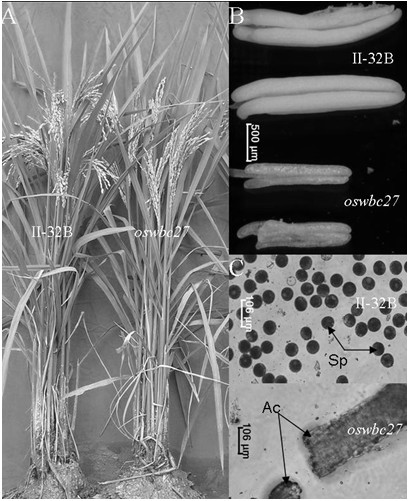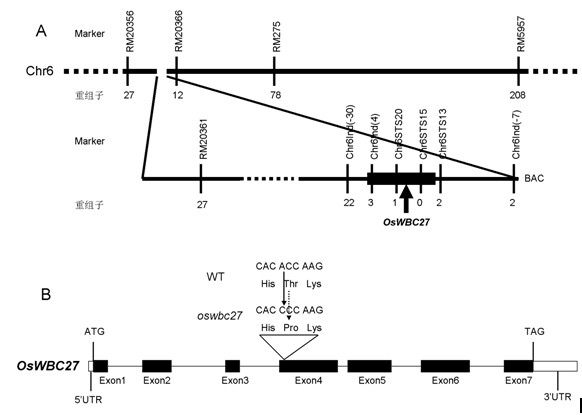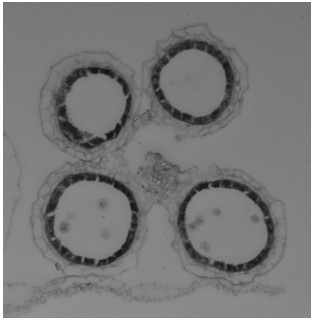Anther tapetum specific expression promoter POsABCG15, recombinant expression vector thereof and application thereof
An anther tapetum and expression vector technology, which is applied in the field of genetic engineering, can solve the problems of limited parents, unfree combination of cytoplasmic-nucleus interaction sterile lines, high risk of large-scale seed production, etc., and achieves the effect of wide application prospect.
- Summary
- Abstract
- Description
- Claims
- Application Information
AI Technical Summary
Problems solved by technology
Method used
Image
Examples
Embodiment 1
[0025] Embodiment 1, osabcg15 Obtaining Mutant Plants and Morphological Observation
[0026] Indica rice Jinhui No. 1 mutant named osabcg15 Mutants were preserved by our laboratory, using II-32B as recurrent parent, and osabcg15 The mutants were crossed and alternated backcrossed, and the mutants were finally preserved. The sterile material and II-32B were a pair of near-isogenic lines. osabcg15 Mutants were crossed with II-32B, and the F1 generation was all fertile, and segregation occurred in the self-crossed F2 generation, of which 567 were normal plants and 187 were mutants, and the ratio was 3:1 (χ2 = 0.0071 osabcg15 Morphological observation of mutant plants: II-32B rice ears droop after fruiting ( figure 1 A left), while osabcg15 The mutant spikelets were not fruiting and were erect ( figure 1 A right); II-32B anther contains mature pollen and appears yellow ( figure 1 on B), osabcg15 The mutant anthers are white ( figure 1 Lower B); II-32B pollen...
Embodiment 2
[0027] Embodiment 2, OsABCG15 Gene mapping and cloning
[0028] 1. Positioning groups
[0029] Will osabcg15 The mutant was crossed with the japonica rice Nipponbare, the F2 generation was obtained by selfing, and the male sterile plants were selected as the positioning population.
[0030] 2. Extraction of rice DNA
[0031] Parents were extracted using the improved CTAB method, including the following steps: Take 0.1-0.2 grams (about half a piece) of leaves and put them in a small mortar, add an appropriate amount of liquid nitrogen, grind them to powder immediately, put them into a 2m1 centrifuge tube, and add 700μL Put the 1.5×CTAB solution preheated at 100°C in a centrifuge tube, mix it carefully, put it in a 65°C water bath, take out the centrifuge tube after 20 minutes, add an equal volume of chloroform / isoamyl alcohol, mix vigorously, centrifuge at 13000rpm for 10 minutes, and take Put the supernatant in a new tube, add 900 μL of absolute ethanol and mix wel...
Embodiment 3
[0038] Embodiment 3, anther tapetum-specific expression promoter POsABCG15 analyze
[0039] The analysis found that the finely positioned OsABCG15 The upstream 2034bp of the gene has an RNA polymerase recognition site, and the nucleotide sequence is shown in SEQ ID NO.31, named as anther tapetum-specific expression promoter, referred to as POsABCG15 . Primers are designed according to the sequence shown in SEQ ID NO.31, the upstream primer is P OsABCG15F:5'-gac aagctt cgaaatgctcggttatatg-3' (SEQ ID NO.32), the underline is the Hind III restriction site; the downstream primer is P OsABCG15R:5'-gc tctaga ctcctccaagagacacag-3' (SEQ ID NO.33), the underline is the Xba I restriction site, amplified by PCR, the PCR reaction conditions are: pre-denaturation at 95°C for 3 minutes; denaturation at 94°C for 45 seconds, annealing at 61°C for 45 seconds, Extend at 72°C for 2 minutes, 28 cycles, and finally extend at 72°C for 10 minutes. The PCR product was identified by agaros...
PUM
 Login to View More
Login to View More Abstract
Description
Claims
Application Information
 Login to View More
Login to View More - R&D
- Intellectual Property
- Life Sciences
- Materials
- Tech Scout
- Unparalleled Data Quality
- Higher Quality Content
- 60% Fewer Hallucinations
Browse by: Latest US Patents, China's latest patents, Technical Efficacy Thesaurus, Application Domain, Technology Topic, Popular Technical Reports.
© 2025 PatSnap. All rights reserved.Legal|Privacy policy|Modern Slavery Act Transparency Statement|Sitemap|About US| Contact US: help@patsnap.com



